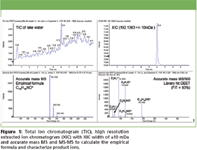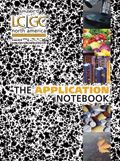Identifying Unexpected Environmental Contaminants with High-Resolution, Accurate Mass LC–MS-MS
This paper describes the use of the AB SCIEX TripleTOF 5600 LC–MS-MS system for the screening and identification of unexpected contaminants in lake water, demonstrating the value of high-resolution, accurate-mass data, and retrospective data processing for the identification of nontargeted compounds.
Andre Schreiber, AB SCIEX
This paper describes the use of the AB SCIEX TripleTOF™ 5600 LC–MS-MS system for the screening and identification of unexpected contaminants in lake water, demonstrating the value of high-resolution, accurate-mass data, and retrospective data processing for the identification of nontargeted compounds.
Experimental
The AB SCIEX TripleTOF™ 5600 LC–MS-MS system (AB SCIEX, Concord, ON) equipped with TurboV™ source and an ESI probe was used. Full-scan MS spectra were acquired over the mass range of 100–1000 Da with an accumulation time of 100 ms. Information dependent acquisition (IDA) was used to trigger full scan MS-MS experiments using standardized settings of collision energy (CE) =35 V and collision energy spread (CES) = ±15 V. The MS-MS accumulation time was set to 25 ms.

Figure 1
Discussion and Results
High-resolution, accurate-mass, full-scan MS chromatograms allow retrospective data mining to identify nontarget and unexpected analytes. As previously presented statistical data analysis is an important tool to find the unexpected in complex samples (1). A large set of environmental water samples were compared by Principal Components Analysis (PCA) using MarkerView™ Software. The scores plot of PCA help to visualize differences between samples and the loadings plot can be used to find the nontarget contaminants responsible for these differences. PCA was used to identify a mass signal of 192 Da to be characteristic for many water samples originating in urban, but also wilderness areas. Using accurate mass and isotopic pattern, Formula Finder Software empirically calculated the formula of the molecular ion of C12H18NO+. Formula Finder Software also uses accurate mass MS-MS information to characterize the structure based on formula assignment for each major product ion. Finally, the MS-MS spectrum was searched against a comprehensive LC–MS-MS library with PeakView™ Software (AB SCIEX), and the FIT value of 96% identified the detected compound clearly as the mosquito repellent DEET. With this information, DEET can be added to the list of pesticides commonly monitored.
Reference
(1) A. Schreiber, N. Pace, LCGC Chromatography Online (March 2010).

AB SCIEX
353 Hatch Drive, Foster City, CA 94404
tel. (650)638-5800, (800)952-4716; fax (650)638-5884
Email: ServiceSales@absciex.com; Website: www.absciex.com

Separation of Ultra-Short and Long Chain PFAS Compounds Using a Positive Charge Surface Column
December 11th 2024A separation of ultra-short and long chain PFAS (C1-C18) is performed on a HALO®PCS Phenyl-Hexyl column along with a HALO®PFAS Delay column which demonstrates excellent retention for both hydrophilic and hydrophobic analytes.














